Home » Archives for 2006
Free Forex Signal 8/12/2006
1. Short Aud/Usd @ 0.7905 or better. Target 0.7850, 0.7780.
2. Long Usd/Jpy @ 114.80 or better. Target 115.60, 116.70.
Happy Trading. Btw I cannot be held responsible for any loss from the signal above.
In The Land Of Forex
Those are the words i hold on to in forex. No matter what happen in technical or fundamental study. Always follow the trend. Trend is king. Follow the king and you will be rewarded handsomely.
Free Forex Signal 10/11/2006
Eur/Usd is currently at 1.2862. From my calculation Eur/Usd has an upper range of 1.2880 - 1.2950. Possible trade is short Eur/Usd @ 1.2880 or better.
Gbp/Usd
Gbp/Usd is currently at 1.9102. As stated in my other blog, possible trade is short Gbp/Usd @ 1.9100 or better wih upper range of 1.9100 -1.9150
Aud/Usd
Possible trade short Aud/Usd @ 0.7710 or better. Already gone down now. Btw i shorted from 0.7751. Its a good trade so far.
Forex Trade Review
Anyway Im going to review few pairs. Maybe some of you can find a trade from my review. As for me I am currently out of the market waiting for it to come to sense. Currently all pairs are at extreme oversold or overbought.
Eur/Usd
Currently at 1.2532 after a drop of almost 200 pips. Currently its on a thin downtrend with a possible target of 1.2450. For those of you who are already on a short position, you may hold the position with trailing stop loss of your choice. For me I will only consider an entry at 1.2450, that will depend on the strength of the momentum.
Gbp/Usd
Currently at 1.8540 and just like eur/usd it drop like a rock during NFP report out. Possible target is 1.8200. Looks like a retrace coming soon. Just watch the trend and momentum for possible entry. I will be looking at this one.
Usd/Cad
Currently at 1.1330. My last signal manage to get me 30 pips. Too small for the effort. Currently going up with possible target of 1.1450. Overshot all indicators. Possible retrace at 1.1360. I will be watching this one.
This is my review. Its not a trade recommendation. Be very carefull on your trade coz forex is a risky market. If you are not sure better stay out until the market make some sense. Happy trading.

Forex Signal
usd/cad is currently at 1.1270 with a high of 1.1305. Looking at the chart, it has lost its momentum eventhough the uptrend is still intact. It may hover around 1.1240 - 1.1310 for a while.
Possible Trade:
Short usd/cad @ 1.1300 or better.
Target: 1.1180, 1.11201, 1.1080.
Caution:
If usd/cad overshoot 1.1315, then its possible that it will go long. This is because usd/cad is currently going uptrend. It will be constantly making new high.
555 Forex Trading System
Time Frame : 4 hours
MA's : SMA5 or SMA8 which ever suits you better, SMA55
TSF : Period=55
Bollinger Band : MA=simple, Period=55, Multiple=2.0
Stochastic Slow : Period = 10,3,3, simple, simple
Stochastic Fast : Period = 13,3 Exponential
 For the 1st chart I use usd/jpy pair for 4 hour timeframe. Remember this forex system is designed for 4 hour time frame but can be use on all pairs. In this forex system, MA8 (Red) and TSF55 (Blue) is the indicator for long or short trade. When the red is above blue = long and vice versa. BB55 and SMA55 is the target. Both the stochastic is for confirmation on trade position.
For the 1st chart I use usd/jpy pair for 4 hour timeframe. Remember this forex system is designed for 4 hour time frame but can be use on all pairs. In this forex system, MA8 (Red) and TSF55 (Blue) is the indicator for long or short trade. When the red is above blue = long and vice versa. BB55 and SMA55 is the target. Both the stochastic is for confirmation on trade position.
When price is at BB55 either at the top or bottom and both stochastic is showing extreme value, it may signal a reversal. A confirm reversal is when price broke the red and blue line. The price itself is the ultimate indicator. Once the price broke the 2 lines, find the best possible entry. Normally the best entry is when the price is at the blue line. If after you enter the trade, and the price gain momentum in your favour just let it run and ride it till its finish.
Below is the explaination for the above chart
- Price spike out of BB55. As mentioned before, BB55 acts as targets. In this case usd/jpy already reach its target based on this system but the momentum is still strong based on distance of Red and Blue line.
- Price spike out of BB55 again but this time the price close below the Red line. This indicates the momentum is dead and a reversal coming soon.
- Ideal entry. Red below Blue line indicates a short position. Price is at the Blue line. Short now and let it run until it meet BB55 at the bottom
- Price went through BB55 and then goes flat at this point. It is making its way back into BB55 and a flat Red line indicating the momentum is dead and a reversal is coming soon. At this point the entry for long position is the lowest price inside BB55.
- Price spike out of BB55 but cannot make new high. This is where I exit and enter a new short position. Let it run until the momentum is dead.
If you look at point 1,2,3 and 5. All are high point and all of them is higher than the previous high. This is and indication that usd/jpy is actually going up but as forex moves in waves we sometimes get lost and fail to see the big picture. In this case what ever you do, follow the trend and always remember that the big picture is usd/jpy is going uptrend. Be prepare if the market suddenly shoot up. Remember always use stop loss properly. Forex is a risky market, do manage your risk properly.

Catch The Dow and Elliott Waves
One of Dow's powerful concepts is the three-waves principle. Decades after Dow first wrote on the subject, R.N. Elliott took up the cause to create his unique Elliot Wave Theory. So let's combine their work, and see what these guys taught us a few dozen years before we discovered the markets were a good place to hang out.
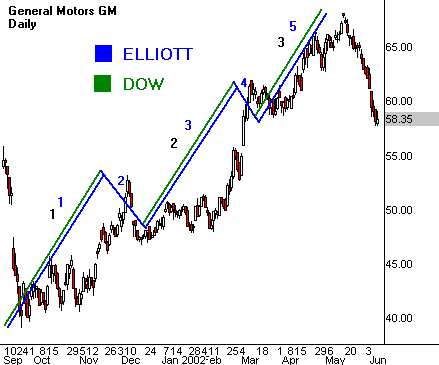
Dow's three waves were built on the concept of the primary trend. We all know what Charlie was talking about here. The primary trend is the major market direction over years or decades. This is how we determine whether we're in a bull market or a bear market. Dow determined this primary trend by looking at long-term price patterns and seeing the obvious.
Elliott used his five-wave trend to reach the same conclusions. He noted that the primary trend was composed of three waves moving in the major direction and two waves moving against it. Furthermore, each primary wave hid a smaller wave structure that exposed the true nature of price direction. For example, Elliott commented that failures exhibited a rollover of certain waves within this fractal structure and gave rise to trend reversals.
In Dow's world, a market printing higher highs and higher lows revealed a primary bull trend. Conversely, a market printing lower highs and lower lows revealed a primary bear trend. Elliott had no problem with this view, but he added a few twists of his own. For example, he pointed out how certain phases of a primary trend showed very limited counter-waves and rarely pulled back until the entire wave set was completed.
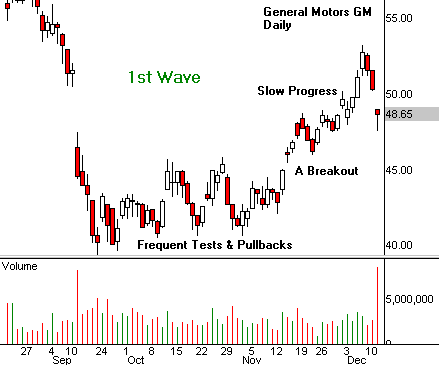
Three-wave principles get more interesting when Dow and Elliott describe characteristic crowd behavior in each of the waves. Let's examine these through a bull market cycle.
The first wave triggers value buying by patient investors who anticipate better economic conditions and long-term growth. This occurs during the same period that sentiment records its lowest readings and experts tell everyone in sight to stay away from the financial markets. Value investors wake up from this gloom and realize that the fear-filled talk hides a nascent recovery. They buy aggressively from distressed sellers and nurture a sustainable bottom.
Elliott noted that this first wave shows very gradual price improvement and turns back on itself frequently to test lower levels. He also points out that this wave takes a long time to complete and gives a true bottoming appearance to the chart. The good news is that the market eventually triggers enough momentum to carry price up to much higher levels.
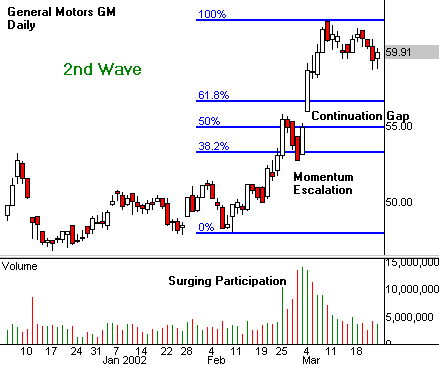
Bullish evidence begins to mount in Dow's second wave. Improved corporate earnings, increased employment and unexpected innovation characterize this midpoint of a broad bull move. Less demanding investors now enter the market because they see better times ahead and want to participate. They build good-sized portfolios and start to follow the markets with great interest.
Elliott sees this wave as the most dependable phase of the entire bull cycle. Price movement advances rapidly, with less overlap from day to day. Small gaps appear between bars as investors buy high and look to sell higher. A sharp advance often triggers right in the middle of the wave, when a burst of enthusiasm forces a wide continuation gap. This powerful move often marks the exact middle for the entire three-wave event.
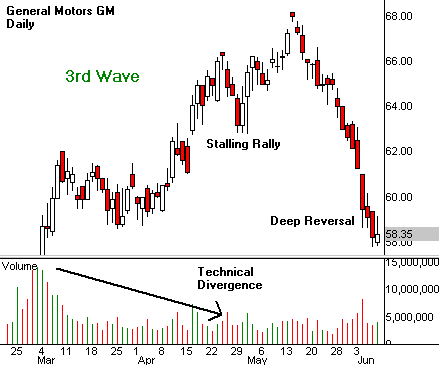
Danger signs grow during Dow's third wave, but they're hard to accept because of an outstanding market environment. Record earnings and full employment lead the media to proclaim an era in which the sky's the limit. Joe Sixpack now joins the hunt as the public forgets about its losses from the last bear cycle. This broad market participation starts a buying panic. At this very moment, the smart-money investors who bought at the bottom begin to unload their positions into the hands of the waiting public. The market eventually runs out of gas and prints a long-term top.
The last wave in Elliott's world can show a parabolic spike, or a failure move before it gets under way. This dichotomy points out the danger the public faces when it enters the stock market in force. Elliott noted that the large-scale reversal off this last wave may be very deep and painful. As we now know from personal experience, this rapid selloff addresses the many sins common to all bull cycles.
Practice Your Exit Strategy
Exit planning must deal with the good, the bad and the ugly. In other words, keep a profit protection strategy to exit winning trades, a stop loss strategy to get out of bad ones and a fire drill in case disaster strikes. You'll need all three tactics in every trade, because anything can happen once you hit the order button.
Your holding period guides the profit side of the exit equation. Always seek the reward target that matches your time in the market. In other words, trade the most profitable move from your entry to the target within the time frame that you're long or short the stock. This lets you apply both a time- and a price-based exit strategy to your winners.
A time-based exit strategy requires little interpretation. Focus on your holding period's time window rather than the price action. Exit the trade immediately when price hits the reward target at the right time. Exit the trade before price hits the reward target if the window starts to close. The trick with time-based strategies is to look for the best price available within the chosen window.
Most traders should start with a price-based exit strategy. For example, you enter a long position, and it moves into a profit. It rallies at a moderate pace and hits your reward target within the holding period. You exit the trade "blind" at the reward price. This means you take the money and go, without considering the current price action.
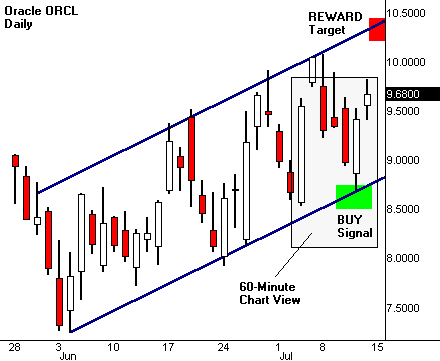
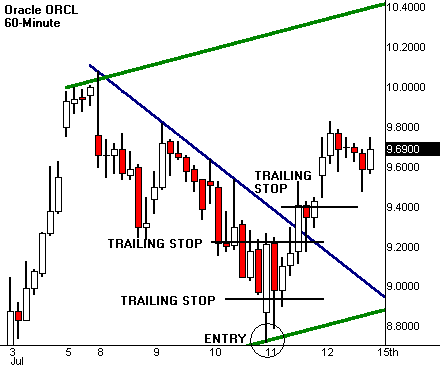
You've just taken a nice profit in a perfect world, but how do you protect yourself in the real one? Start by focusing on trends within shorter-term time frames. For example, when trading a daily chart, manage profit and loss using a 60-minute chart whenever possible. The shorter-term pattern will tell you when to move the stop in order to protect profits, or when to exit the trade entirely.
Let's outline common stages for a long position that eventually reaches the reward target:
- Price moves into a profit.
- Price reaches first resistance, and reverses.
- Price finds support and rallies through first resistance.
This action/reaction continues until price reaches the target. In this scenario, trade management requires a breakeven stop as soon as price moves into a profit. This stop should be moved up after the first reversal, but stay below short-term support. When price finally rallies above first resistance, move the stop just below this new level. Continue the process until the position hits the reward target.
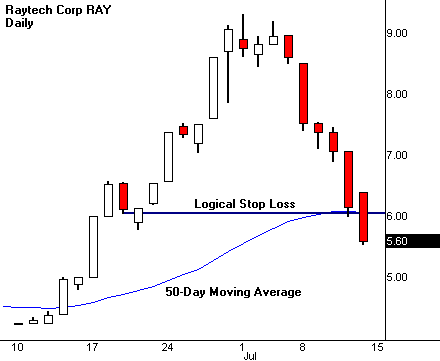
Profits are nice, but many trades go haywire right away. The exit strategy is very simple in this situation: get out as soon as price breaks support on a long trade, or resistance on a short sale. This may sound simple, but there are two problems. First, many of us lack the discipline to take losses when they should be taken. Second, many of us don't understand how to place stop losses in the first place.
Take your loss when the market says you're wrong. Every setup has a trigger that violates the pattern you intend to trade. Identify this price in advance, and place your stop just behind it. Remember that this magic number changes dynamically with each new bar, so you need to adjust it often. But don't remove it under any circumstances.
Do you get frustrated because your stops get hit frequently on good trades? The fault lies in your analysis and trade management, not in the stops themselves. Many traders believe they can improve their performance by placing stops where they shouldn't go. Every stock will violate support/resistance up to a point before reversing. Your analysis must consider the stock's underlying volatility, so the stop can be placed outside this "market noise."
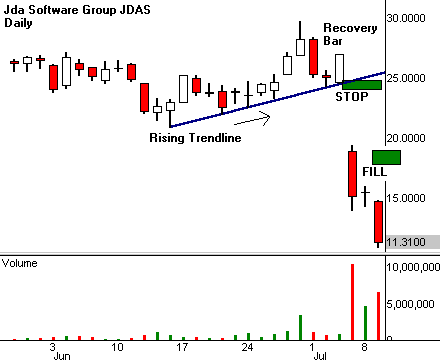 Finally, you need a way to deal with unexpected bad news. Start with a panic drill, and practice it over and over again in your head. The exit strategy is simple: If you can beat the rest of the crowd out of the door, act immediately. The after-hours market can save you a fortune if you learn to use it wisely. If you can't escape right away, watch price action closely and take your best shot. The market can do anything it wants once bad news hits, and you may need to accept a large loss.
Finally, you need a way to deal with unexpected bad news. Start with a panic drill, and practice it over and over again in your head. The exit strategy is simple: If you can beat the rest of the crowd out of the door, act immediately. The after-hours market can save you a fortune if you learn to use it wisely. If you can't escape right away, watch price action closely and take your best shot. The market can do anything it wants once bad news hits, and you may need to accept a large loss.Sudden losses are a cost of doing business as a trader. Full disclosure rules and external events will impact your bottom line from time to time. Reduce your risk by choosing lower-volatility stocks to carry over longer time periods. Avoid holding anything through earnings reports or terrorist threats. Remember, it's not hard to rebuild profits after the unexpected takes a bite out of your bottom line.
Effective Market Timing
I publish hundreds of trade setups each month. But none of these ideas will put money in your pocket without good timing. It's a critical error to enter a trade just because it has a pretty chart. The opportunity comes only when you can discover and capitalize on the setup's timing signals.
Careful entry bridges the gap between the setup and the trade. This is the door through which you take on monetary and emotional risk. There are many ways to time the market, but three strategies work for most swing trades. First, enter a breakout or breakdown after it's under way. Second, wait for a pullback and enter near support/resistance. Third, buy or sell within a narrow range before the move begins.
Which is the best entry strategy for your next trade? Unfortunately, the right answer is never the same twice. Don't try to render entry rules into simple repetitive tasks. In truth, you need to plan each trade within the context of the current market environment, reward-to-risk ratio and chosen holding period. This extra effort is a necessity, not a luxury.
Let's examine these three entry strategies. Over time you'll learn how to pick the best one for the trade you're ready to make. Keep in mind that several different strategies might work with the same setup. The right choice could have more to do with intestinal fortitude than market timing.
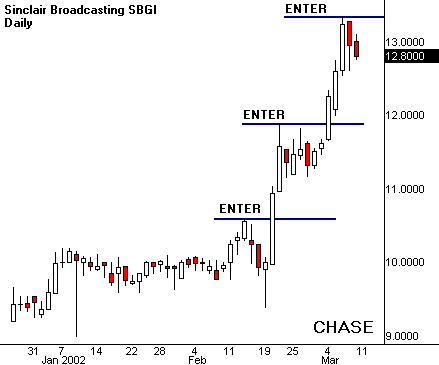
Buying a breakout or selling a breakdown is the only timing method employed by most traders. Unfortunately, it's also the best way to wash out of the markets. This entry technique is simple. Your setup breaks through support or resistance, so you rush in to place a position. And then you pray.
This is a very risky way to enter the market. The trade looks great when it moves in your direction, but what do you do if it reverses and takes off the other way? Amazingly, most folks don't have a good answer to this important question. So they freeze like a deer in the headlights when faced with the reality.
Chasing momentum can work if traders choose their plays wisely and pay close attention to two important rules. First, always establish your risk before making the trade. Choose a flat stop-loss percentage, or use a pattern in a lower time frame to signal when the trade goes against you. Second, make sure the broader market offers adequate support for your strategy. Momentum stocks benefit from momentum markets.
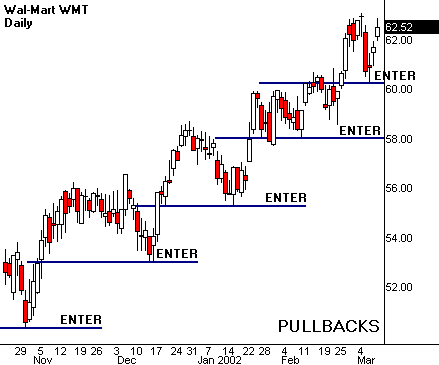
What's your rush? Many traders believe they're too late when they stumble across a breakout in progress. In fact, they're often too early. Many times you're better off standing aside and waiting for the market to reverse, rather than jumping in with the crowd. Pullback entry is a very powerful method because it uses the eager capital of those who missed the first move. But the trick is to get into the trade before they do, and let their enthusiasm carry you into a profit.
Pullback entry is very price-sensitive. If possible, place a limit order where you expect the pullback to shift toward the breakout direction. This is actually easier than it sounds. New trends frequently return to prior support/resistance before momentum finally kicks in. So look at the chart and find where the initial breakout took place. Pullbacks often move to these important levels like magnets.
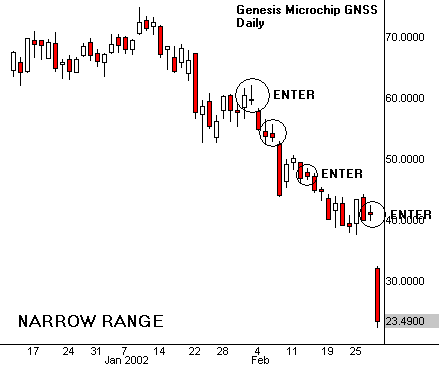 Narrow range entry confuses many traders, but the theory is simple. Common sense dictates the best time to enter a new position is just before a breakout or breakdown. Narrow range uses characteristics of low volatility to identify when conditions are ripe for a big move. The trader enters at a tight price level and waits for a move to begin. The advantage is that the position can be exited for a small loss if the market breaks the other way.
Narrow range entry confuses many traders, but the theory is simple. Common sense dictates the best time to enter a new position is just before a breakout or breakdown. Narrow range uses characteristics of low volatility to identify when conditions are ripe for a big move. The trader enters at a tight price level and waits for a move to begin. The advantage is that the position can be exited for a small loss if the market breaks the other way.Congestion patterns, such as triangles, often look like coiled springs. Paradoxically, this wound-up appearance predicts the return of rapid price movement. Traders can use classic indicators, such as historical volatility, to identify trigger points for this movement. But a better way is to locate narrow range bars and declining volume right at key support/resistance levels. Enter the trade here while everyone else gets ready to chase the breakout or breakdown.
Trend, Direction and Timing
- What is the trend or range intensity?
- What is the direction of the next price move?
- When will this move occur?
Concentrate on the three Cs to find the answers you need to make the trade. Recognize trend-range intensity through time-frame convergence. Predict price direction through the will of the crowd. And align market timing through range contraction.
Markets alternate between up-down trends and sideways ranges. This is true in all time frames. Price movement swings through synergy and conflict as trends collide or converge. The strongest trends emerge when multiple time frames stack up into directional movement. The most persistent ranges appear when multilayered conflict stalls price change.
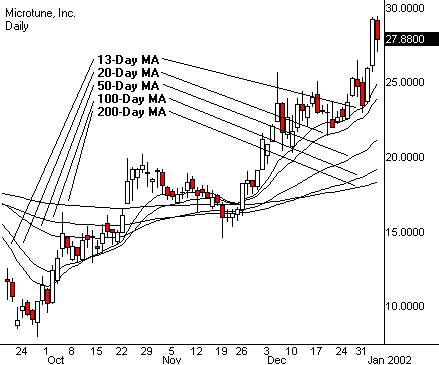
Use moving average ribbons (MARs) to study trend intensity. These handy tools illustrate complex relationships through simple interactions. Start by finding where current price sits in the ribbons. Since price always moves toward or away from underlying averages, each new bar reveals characteristics of momentum, trend and time. Tie MARs together in a logical way. For example, use 20-, 50- and 200-day averages to view distinct short, intermediate and long-term trends.
The interplay between averages exposes market phases and trend acceleration. Look for a bear market when MARs flip over and the 200-day MA sits on top. Look for the bull to return when it crosses back and each MA lines up, from shortest to longest. Expect choppy action when averages criss-cross out of sequence. Price, for example, can bounce like a pinball when it gets caught between inverted averages.
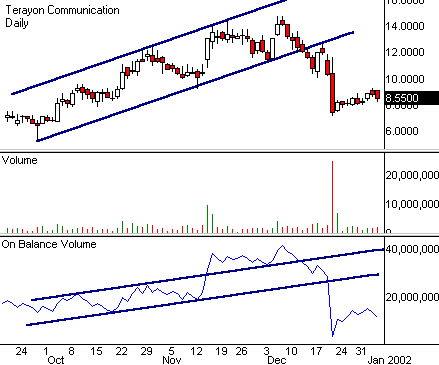
Volume defines the crowd. Studying market volume has two primary functions. First, it gauges the strength of ownership and the passion of the owners. Second, it filters the crowd's divergent impulses and predicts their herd behavior. Capture this vital information with a simple volume histogram (preferably color-coded) and an accumulation indicator such as on-balance volume (OBV). Volume is deceptively simple. The lack of a clear relationship between price and volume undermines accurate prediction. Volume leads the crowd as often as it lags, but always makes perfect sense in hindsight. Examine price action closely before timing trades to a volume pattern. And move quickly to other opportunities when the crowd gives mixed signals.
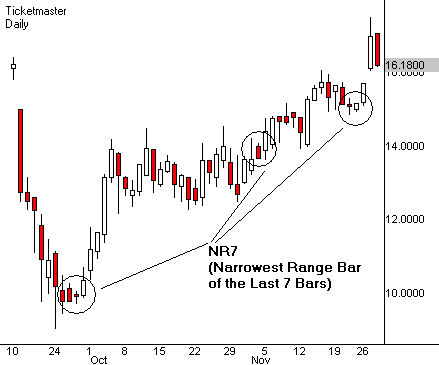 Range-bound markets lower volatility and dissipate crowd excitement. Eventually congestion reaches a balance point where a new trend can begin. This cooling-off phase sounds simple, but it's very hard to trade profitably. Declining volatility fosters crowd disinterest, profit taking and indecision. The chart draws a series of narrowing range bars (the distance from bar high to low). Then a new trend explodes just when everyone turns their backs, but most miss the trade because it gathers no crowd until it passes.
Range-bound markets lower volatility and dissipate crowd excitement. Eventually congestion reaches a balance point where a new trend can begin. This cooling-off phase sounds simple, but it's very hard to trade profitably. Declining volatility fosters crowd disinterest, profit taking and indecision. The chart draws a series of narrowing range bars (the distance from bar high to low). Then a new trend explodes just when everyone turns their backs, but most miss the trade because it gathers no crowd until it passes.Find the narrowest range bar of the last seven bars (NR7) to locate this sudden congestion breakout. Its predictive power lies in the location where it appears. NR7s work best right in the middle of congestion, or when price pushes repeatedly against a major barrier. When the signal works, it works fast and triggers a major price expansion without a pullback.
How do you trade an NR7? Place an entry stop just outside both price extremes at the same time, and then cancel one order after the other executes. Then place a stop loss at the location of the cancelled order. This takes advantage of the small pattern, regardless of the way it eventually breaks out.
You can answer the three questions with a single price chart and a few good indicators. This way you'll know what to do next with very little effort. Get on board quickly when everything converges and points to an impending move. Multiple signals reveal crowd forces that converge into intense breakouts or breakdowns. These focused time-price zones line up with the right answers at the right time.
Sumber www.tradingday.com
Bilateral Trade Setups
Start by overcoming directional bias when you look at a price pattern. Although you may see it in your mind as a long or a short, chances are it will work in either direction. The trick is to let the price action tell you which way to go.
Let's back up a step and see how this works. Many patterns exhibit well-defined support and resistance. Bilateral setups use both levels for trade execution. A long entry is signaled if price breaks resistance to the upside. Conversely, a short sale is signaled if price breaks support to the downside. But you still have more work to do before taking a bilateral trade. After all, making money is the whole point of the exercise.
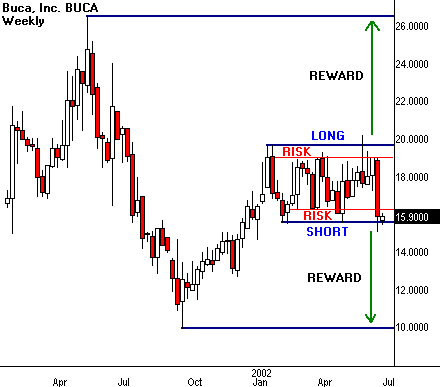
Every trade setup generates a unique reward/risk profile. In other words, it tells you how much you stand to win or lose should you decide to take a position. Each side of a bilateral setup carries a different reward/risk ratio. Most of the time, one side shows more profit potential than the other side. This can be frustrating because the calculation is independent of the odds that either outcome will actually take place. So you may have a great, high-odds setup with little or no reward, or a lousy, low-odds setup that would earn a fortune if it ever happens.
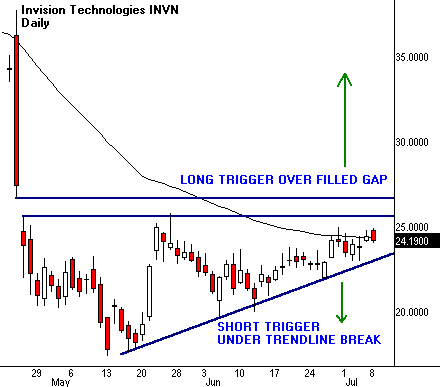
The price trigger complicates bilateral trade entry. Trading signals come in all varieties. The best ones ring very loud bells within very narrow price levels. One classic example is a high-volume breakout through a major moving average. Bilateral strategies force you to locate trigger prices on both sides of the pattern. Many times one side will bark much louder than the other when price hits the associated trigger.
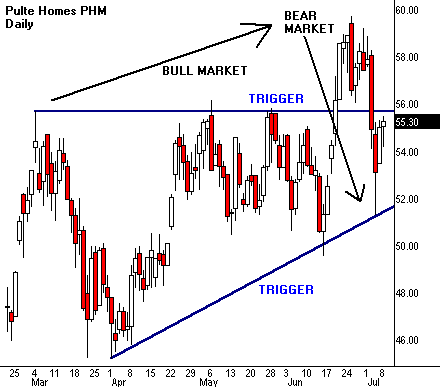
Bilateral setups work best when they fit into larger cycles that encourage price movement in either direction. For example, a stock drops off a broad rally into an extended correction. Smaller patterns within this correction may trigger short-term rallies or selloffs. Bilateral strategy lets the trader take advantage of the mixed environment and execute price swings in both directions.
Let's review the signposts of this two-way trading street. We need well-defined support-resistance levels, a defined reward/risk ratio on both sides of the equation, clean price triggers and a big picture that lets us execute in either direction. Sounds simple enough, and it is.
The difficulty lies in our ability to control bias and to let the market tell us which way to go. Very often the best trade is in the opposite direction from the most obvious outcome for that pattern. In other words, the majority piles in one way, but the profit comes from trading it the other way.
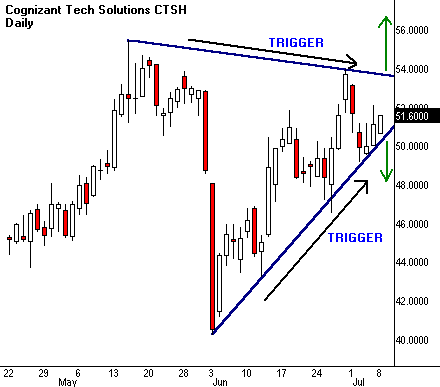 The good news about these fascinating patterns is they may tell you when the move is about to happen. Congestion often narrows toward a trigger point. We see this in triangle patterns where two trendlines converge in price and time. Bilateral setups may show this convergence through simple lines, or sometimes through more complicated volatility cycles.
The good news about these fascinating patterns is they may tell you when the move is about to happen. Congestion often narrows toward a trigger point. We see this in triangle patterns where two trendlines converge in price and time. Bilateral setups may show this convergence through simple lines, or sometimes through more complicated volatility cycles.Volatility drops off through the formation of most bilateral patterns. It tends to reach a definable low, and then trigger a sharp price expansion. Traders examine narrow range price bars near support or resistance levels in order to predict impending price triggers. They also study classic volatility indicators to locate these turning points in developing patterns.
Swing traders go long or short, depending on the opportunity. Bilateral setups cut their workloads by presenting two possible trades in a single pattern. So always look at both sides of the equation when examining a price chart. Then leave your bias at the door, and take whatever the market gives you.
Sumber www.tradingday.com
Free Forex Signal
If anyone here like to see what kind of signal I give here is one example . Btw in that signal gbp/usd gave me over 300 pips. Happy trading.
Marketiva Scam????
"I would not trust any company with no background info. I had asked to see who or what is behind the company before depositing funds. No response. I believe there is some type of long term scam here. Something is not right compared to other brokers. Also it is a bit strange that you can open an acct. with no I.D. Last but not least, beware the glowing reviews of Marketiva spread out on forums. Most if not all of these posts are made by actual Marketiva admins posing fraudulently as investors. You can easily pick them out. They are the ones using obvious marketing slogans and pushing the free $5 for joining. The $5 is just a ploy to sucker in the new trader.The rest of the posts are from those promoting their referral links.I'm of the opinion that Marketiva is a total bucket shop. Like a ponzi, the money from losers lines the pockets of Marketiva and helps pay the few that make a profit. I seriously doubt any investor's money actually makes it onto the market. 95% of traders lose on average. This makes for a profitable business model especially when the investor is essentially trading on a demo account with real money. They know you are very likely to lose, so your money goes into the bucket and you are left blaming a bad market when you lose when in fact, your money never even made it there.Ok, thats enough ranting. Beware Marketiva and do your own research and due diligence checks on any broker you wish to join.Best of luck out there!"
Trend, Momentum and Timing
Trend
Trend is the tendency of movement to a particular direction. When it is uptrend, the price will move up and vice versa.
Momentum.
Momentum is the strength of movement. The stronger the momentum the stronger the move. When the momentum is finished, it will reverse.
Timing
Timing is when u enter the market. Enter only when the profit to risk ratio is good. Other than that better stay out.
What is a Pip?
The most common increment of currencies is the Pip. If the EUR/USD moves from 1.2250 to 1.2251, that is ONE PIP. A pip is the last decimal place of a quotation. The Pip is how you measure your profit or loss.
As each currency has its own value, it is necessary to calculate the value of a pip for that particular currency. In currencies where the US Dollar is quoted first, the calculation would be as follows.
Let’s take USD/JPY rate at 119.80 (notice this currency pair only goes to two decimal places, most of the other currencies have four decimal places)
In the case of USD/JPY, 1 pip would be .01
Therefore,
USD/JPY:
119.80
.01 divided by exchange rate = pip value
.01 / 119.80 = 0.0000834This looks like a very long number but later we will discuss lot size.
USD/CHF:
1.5250
.0001 divided by exchange rate = pip value
.0001 / 1.5250 = 0.0000655USD/CAD:
1.4890
.0001 divided by exchange rate = pip value
.0001 / 1.4890 = 0.00006715
In the case where the US Dollar is not quoted first and we want to get the US Dollar value, we have to add one more step.
EUR/USD:
1.2200
.0001 divided by exchange rate = pip value
so
.0001 / 1.2200 = EUR 0.0008196but we need to get back to US dollars so we add another calculation which is
EUR x Exchange rate
So
0.0008196 x 1.2200 = 0.00009999When rounded up it would be 0.0001
GBP/USD:
1.7975
.0001 / 1.7975 = GBP 0.0000556
.0001 divided by exchange rate = pip value
So
But we need to get back to US dollars so we add another calculation which is
GBP x Exchange rate
So
0.0000556 x 1.7975 = 0.0000998When rounded up it would be 0.0001
You’re probably rolling your eyes back and thinking do I really need to work all this out and the answer is no. Nearly all forex brokers will work all this out for you automatically. It’s always good for you to know how they work it out.
How To Make Money Trading Forex
The object of forex trading is to exchange one currency for another in the expectation that the price will change so that the currency you bought will increase in value compared to the one you sold.
How to Read Forex Quote
Currencies are always quoted in pairs, such as EUR/USD or USD/CHF. The reason they are quoted in pairs is because in every foreign exchange transaction you are simultanesouly buying one currency and selling another. Here is an example of a foreign exchange rate of the British pound versus the U.S. dollar:
GBP/USD = 1.7500
The currency to the left of the slash ("/") is called the base currency (in this example, the British pound) and the one on the right is called the quote currency or counter currency (in this example, the U.S. dollar).
When buying, the exchange rate tells you how much you have to pay in units of the quote currency to buy one unit of the base currency. In the example above, you have to pay 1.7500 U.S. dollar to buy 1 British pound.
When selling, the exchange rate tells you how many units of the quote currency you get for selling one of the basis currency. In the example above, you will receive 1.7500 U.S. dollar when you sell 1 British pound.
The base currency is the “basis” for the buy or the sell. If you buy EUR/USD this simply means that you are buying the base currency and simultaneously selling the quote currency.
You would buy the pair if you belive the base currency will appreciate relative to the quote currency. You would sell the pair if you think the base currency will depreciate relative to the count currency.
Long/Short
First, you should determine whether you want to buy or sell.
If you want to buy (which actually means buy the base currency and sell the quote currency), you want the base currency to rise in value and then you would sell it back at a higher price. In trader's talk, this is called "going long" or taking a "long position". Just remember: long = buy.
If you want to sell (which actually means sell the base currency and buy the quote currency), you want the base currency to fall in value and then you would buy it back at a lower price. This is called "going short" or taking a "short position". Short = sell.
Bid/Ask Spread
All Forex quotes include a two-way price, the bid and ask. The bid is always lower than the ask price.
The bid is the price in which the dealer is willing to buy the base currency in exchange for the quote currency. This means the bid is the price in which you the trader will sell.
The ask is the price at which the dealer will sell the base currency in exchange for the quote currency. This means the ask is the price in which you the trader will buy.
The difference between the bid and the ask price is popularly know as the spread.
Let's take a look at an example taken from a trading software:
On this EUR/USD quote, the bid price is 1.2293 and the ask price is 1.2296. Look at how this broker makes it so easy for you to trade away your money. If you want to sell EUR, you click "Sell" and you will sell Euros at 1.2293. If you want to buy EUR, you click "Buy" and you will buy Euros at 1.2296.
In the following examples, I am going to use fundamental analysis to help us decide whether to buy or sell a specific currency pair. If you always fell asleep during your economics class or just flat out skipped economics class, don’t worry, we will cover fundamental analysis in a later lesson. For right now, try to pretend you know what’s going on.
EUR/USD
In this example euro is the base currency and thus the “basis” for the buy/sell.
If you believe that the US economy will continue to weaken, which is bad for the US dollar, you would execute a BUY EUR/USD order. By doing so you have bought euros in the expectation that they will rise versus the US dollar. If you believe that the US economy is strong and the euro will weaken against the US dollar you would execute a SELL EUR/USD order. By doing so you have sold euros in the expectation that they will fall versus the US dollar.
USD/JPY
In this example the US dollar is the base currency and thus the “basis” for the buy/sell.
If you think that the Japanese government is going to weaken the Yen in order to help its export industry, you would execute a BUY USD/JPY order. By doing so you have bought U.S dollars in the expectation that they will rise versus the Japanese yen. If you believe that Japanese investors are pulling money out of U.S. financial markets and coverting all their U.S. dollars back to Yen, and this will hurt the US dollar, you would execute a SELL USD/JPY order. By doing so you have sold U.S dollars in the expectation that they will depreciate against the Japanese yen.
GBP/USD
In this example the GBP is the base currency and thus the “basis” for the buy/sell.
If you think the British economy will continue to do better than the United States in terms of growth, you would execute a BUY GBP/USD order. By doing so you have bought pounds in the expectation that they will rise versus the US dollar. If you believe the British's economy is slowing while the United State's economy remains vibrant, you would execute a SELL GBP/USD order. By doing so you have sold pounds in the expectation that they will depreciate against the US dollar.
USD/CHF
In this example the USD is the base currency and thus the “basis” for the buy/sell.
If you think the Swiss franc is overvalued, you would execute a BUY USD/CHF order. By doing so you have bought US dollars in the expectation that they will appreciate versus the Swiss Franc. If you believe that due to instability in Iraq and in U.S. financial markets the dollar will continue to weaken, you would execute a SELL USD/CHF order. By doing so you have sold US dollars in the expectation that they will depreciate against the Swiss franc.
I don't have enough money to buy $10,000 EUR. Can I still trade?
You can with margin trading! Margin trading is simply the term used for trading with borrowed capital. This is how you're able to open $10,000 or $100,000 positions with $50 or $1,000. You can conduct relatively large transactions, very quickly and cheaply, with a small amount of initial capital.
Margin trading in the foreign exchange market is quantified in lots. We will be discussing "lots' more in-depth on our next lesson. For now, just think of the term "lot" as the minimun amount of currencies you have to buy. When you go to the grocery store and want to buy an egg, you can't just buy a single egg, they come in dozens or "lots" of 12. In Forex, it'd be foolish to buy or sell $1 EUR, they usually come in "lots" of $10,000 or $100,000 depending on the type of account you have.
For Example:
You believe that signals in the market are indicating that the British Pound will go up against the US Dollar. You open 1 lot ($100,000) for buying the Pound with a 1% margin at the price of 1.5000 and wait for the exchange rate to climb. This means you now control $100,000 worth of British Pound with $1,000. Your predictions come true and you decide to sell. You close the position at 1.5050. You earn 50 pips or about $500. (A pip is the smallest price movement available in a currency). So for an initial capital investment of $1,000, you have made 50% return. Return equals your $500 profit divided by your $1,000 you risked to trade.
| Your Actions | GBP | USD | Your Money |
| You buy 100,000 pounds at the GBP/USD exchange rate of 1.5000 | +100,000 | -150,000 | $1,000 |
| You blink for two seconds and the GBP/USD exchange rate rises to 1.5050 and you sell. | -100,000 | +150,500** | $1,500 |
| You have earned a profit of $500. | 0 | +500 |
When you decide to close a position, the deposit that you originally made is returned to you and a calculation of your profits or losses is done. This profit or loss is then credited to your account.
We will also be discussing margin more in-depth in the next lesson, but hopefully you're able to get a basic idea of how margin works.
Rollover
No, this is not the same as rollover minutes from your cell phone carrier. For positions open at 5pm EST, there is a daily rollover interest rate that a trader either pays or earns, depending on your established margin and position in the market. If you do not want to earn or pay interest on your positions, simply make sure it is closed at 5pm EST, the established end of the market day.
Since every currency trade involves borrowing one currency to buy another, interest rollover charges are an inherent part of FX trading. Interest is paid on the currency that is borrowed, and earned on the one that is purchased. If a client is buying a currency with a higher interest rate than the one he/she is borrowing, the net differential will be positive (i.e. USD/JPY) – and the client will earn funds as a result. Ask your broker about specific details regarding rollover.
Welcome To The World Of Forex
Forex is becoming more and more popular due to its availability over the internet and current high speed internet. Some people have made a living out of forex trading. Its not easy but we all have to start somewhere. Here there will be infomation on forex trading, forex brokers, forex signal, forex chart, technical study and fundamental study of forex and lots more.
There will be other posters, other forex traders that will contribute article here. Come and learn to trade forex. See how easy it is actually to make money and to lose money as well.
Emotional Rescue
There are many reasons for these abysmal stats: lack of discipline, lack of money management skills, and the. I think the reason for the poor success rate is that 90% of the traders can’t manage their emotions while trading. This is the demon I fight daily. Money management and discipline are the symptoms, but emotions are the root cause!
From day one of trading the currency markets I have heard every guru shouting at the top of their lungs to cut you r loses and let your profits run. Or that anyone can put on a trade, but it is the professional trader that knows when to exit a trade. It seems like a simple concept to let your profits run and take those profits when the market offers them up to us. But why can’t we get this right?
Emotions!!
The curse of all traders, the last and most difficult skill for us to overcome is to remove the emotions from our trading. Period!! Well I got news for you… you can’!! You, my friend, are a human being and thus an emotional being. OK, so we must trade emotional-less, but that is beyond the realm of most traders.
Letting emotions interfere with your trading can manifest in many ways. Let me just give you some examples of my past (and sometimes present transgressions):
Having the market retrace and return almost to my original entry point, exiting and having the market execute a classic continuation pattern to original target (a target that was selected in advance before the trade was executed)!
What do we do?
I have been following traders that focus solely on trading the news or other fundamental factors. Although this has some merit it won’t do squat for checking your emotions. Technical analysis should be your weapon of choice for keeping your emotions in check. Do you analysis before your trading session. Follow your trading plan (money management and strategy) as though your life depended upon it (your account balance certainly does!!). Visualize your trade execution like Tiger Woods does before every golf shot and above all, trust yourself! I repeat the following mantra before every trading session:
“I am the world’s most disciplined forex trader. I trade my plan and I plan my trade. I trade with confidence and decisiveness. If the reason for me to be in a trade no longer exists I will cut my losses or take profit without hesitation.”
I am an emotional person. It makes me feel alive, however when I trade I want to be a stone-cold, calculating pip capturing fool and leave the emotions for when I shank a drive into the water at the golf course.
Happy Trading!!
Click here to visit my lens!
BTW, did you see Tiger Woods at the press conference after winning the PGA Championship? A reporter asked him if he expects to win every major he plays. Without hesitation Tiger said “yes.” There was an awkward silence while Tiger waited for the next question and the reporter waited for Tiger to expand upon his answer. I loved it and want us all to trade with the kind of confidence and discipline Tiger Woods displays while playing golf!
Seriously
So why is this so critical? Now that you are a trained trader you have probably realized that your Forex Journey has only just begun. You have discovered that there are numerous strategies and approaches to trading this market. You have also noticed that in the end most of the strategies are viable and that the most volatile factor in any trade is the human interaction in the marketplace itself. I am sure, like me, you have discovered you are your own worst enemy! Having a compounding account ensures that you are trading from a centered base. Your pip goal is reserved and very attainable and your entry and exit strategies will reflect this conservative approach. Trading this account will also build discipline and allow you to avoid those huge draw downs. In this account you are not the gambler, but the casino. When was the last time you heard of a casino losing money on their gaming operations? You rely on a strategy to meet your daily pip goal (at least 3:1) and through money management you are keeping the long term odds in your favor like a casino operator. Your actions will then dictate your profitable results!
Do the math! See what your results would be if you started with a $3,000 mini account, risk no more that 5% on any given trade and made just 15 pips per day. How much will your balance be at the end of a year of trading? The results will astound you!!
Happy Trading!!
For more about my trading visit my Lens!!
Make Forex Education Your Top Priority
… “What advice can I provide to all those who are eager to learn the currency market with all that information out there without getting burned?”
I have come up with 3 Golden Rules to follow when evaluating currency training opportunities.
1. Know Thy Self – This is probably the most important advice I can provide. There is good training and bad training. Often the worst training has the best marketing plans. First figure out how you best learn information. Are you the type of person that can read a manual on rocket science and build a spaceship or are you a person that needs to be shown things through personal instruction and repetition? Figure out how you receive and process information and align Forex training source that fits your method of learning.
2. Don’t Believe the Hype – There is no golden system and it will take considerable effort to trade currencies successfully. Accepting these realities before embarking on your Forex Journey can save you tons of money and more importantly time spent climbing up the learning curve! If it sounds too good to be true, then it probably is. This should be no surprise! It is buyers beware market out there. Look for a Forex education company that can provide you with some solid aftercare resources.
3. Be Realistic – It is a journey and all good journeys take time to develop and flourish. This can be a remarkable journey, but one where you are apt to lose your account a few times before you surrender to the market and learn to take what the market is offering for profits that day. Listen to recommendations, but make decisions based on your own criteria, because in the Forex market this skill will serve you well!!
When reading internet-based sales letters or infomercial or forums, just remember that everyone has an opinion, but in the end the only one that matters is your!!
Happy Trading!!
For more information visit my Lens!
Run to the Light
If you have not noticed my posts have been a little less frequent over the past several weeks. I take time in the summer to vacation and renew. I also enjoy going to trainings and seminars. Not all of these events tie directly back into trading currencies, but then again I also have other interest and passions.
I was at one such seminar last week in Los Angeles. I was networking after the event with a bunch of other entrepreneurs. We spoke about all kinds of topics (I was the only trader in the group … surrounded by mostly real estate investors!), but the topic that seemed dominate is the on around making the jump from W4 employee to being out on your own.
I know there are Forex traders out there that enjoy trading, but have never considered taking the leap to trading fulltime. But, if you are one of those that want to trade fulltime then I have some tips for you that would make that transition easier and they do not involve trading!
Be in Control
It goes without saying that you must have supreme confidence in your trading acumen to cross over. Always have a check and balance in place, because there is a fine line between supreme confidence and arrogance. The latter will end your stint faster that a bucket of ice on my hot summer patio in Phoenix. Recognize that you still have one last unexplored psychological hurdle to cross. You won’t have that paycheck to fall back on anymore! This brings another level of pressure that did not exist before.
Build a Business Plan
Like any other professional venue you will have to trade as a business. You should structure you trading within a legal business entity and develop a business plan which will guide your approach to trading.
Understand Wealth Building Principals
Before making the leap you should have the wealth building principals done pat! They are:
Make a constant investment to your account and watch it grow. I have written previously that you should have a separate Forex compounding account where you deploy conservative strategies and just let it grow! You can only withdraw funds from this account to feed other wealth builsing entities such as real estate or business investment. This account will be your golden goose!
Give your investments time for growth. Getting rich slow in some of your accounts is quite OK!
Know your yield. Your financial education will determine your yield. Remember an investment in you will always offer the greatest return. Become a life long student!
Follow these principals will lead to tremendous wealth!
Network!!
Build a network of entrepreneurs and traders. Seek out their knowledge and expertise on items such as health insurance. Take every advantage your corporation will allow.
One final point to consider, think about developing another source of revenue outside of your trading account. At this stage you have developed an expertise that people are willing to pay to access. Finding a way to leverage this could provide an additional stream of income, adding financial flexibility.
These are a few points to consider. It is way more than just pure trading, but necessary steps to ensure your success!
Happy Trading!!
Entries and Exits
Well, I just returned from some well earned rest & relaxation! It is always a good time to escape the heat of the desert during the summer months. One of the things I like to do during my down time is to catch up on my reading. One of the key points on the Roadmap to Forex Success (visit FX Trade Central for more details) is continuous education and one of my favorite ways is to read.
I just finished "Entries & Exits: Visits to Sixteen Trading Rooms" by Dr. Alexander Elder. I have added this book to the "must read" category for anyone who trades. It really does not matter what instrument you trade, this is a gotta have to any success library!
The long and short of it is the Dr. Elder visit 16 traders that he has met and mentored throughout his career. The traders explain, in short story format, how and why they trade the way they do. This is followed my Dr. Elder's commentary on their trades. The "gem" of this book is to follow the commentary of each trader. In theirs words you will gain great insight and knowledge and determine they are no different than us, so similar and so unique. These trader have cracked the code and the nuggets provided will help you do the same. It is a very easy read, a kin to 16 short stories. I encourage you to read each story and reflect on what lessons you can bring into your own trading room.
I don't care if you get this book from me (http://www.squidoo.com/forexjourney), your local library or borrow from a friend ... just get and read this book! It is worth the 10 pips price of admission!!
Happy Trading!!
Where Do We Go From Here?
No USD friendly numbers!
So, where do we go from here? I am not an expert on Forex fundamentals. I do, however, recognize the importance of fundamental analysis in maintaining and confirming the long-term technical view of the currency pairs I trade. Can the long awaiting sentiment change in the USD finally be upon us? Before you get comfortable in your range-trading strategies here are a few points to consider for your summer trading.
The Federal Reserve – My favorite people (ha, ha, not!). Will interest rates continue to rise or will Bernanke and crew take their collective foots of the economic breaks?
Economic News – Do the NFP numbers signal a slowing economy and can we expect trade balance to narrow and foreign capital flows into the US slow?
Energy - Will the EU spat with Russia over energy policy have a greater impact on the global economy? Will the North Atlantic hurricane season be as devistating as last year? With another rough season forecast, it is sure to spook investors!
World Politics - Will the geopolitical situation in Iran and now North Korea be another reversal factor? Will Afghanistan's reviving insurgency rival the intensity in Iraq?
I don’t know the answers, but as we progress in the month I am taking a keener interest in the fundamentals. I do declare myself a technical trader. I am looking for chart patterns, wave patterns and am still best friends with Mr. Fibonacci. However, I am learning to appreciate fundamentals more and more to the point where I now incorporate them as an additional confirmation in my trade plan.
Technicals are the rudder of the sail boat, but fundamentals deliver the wind to the sails!!
Happy Trading!!
Remember FX Trade Central and Forex Journey Lens are great sources for Forex training, education and information!!
Why Forex? Click Here now and discover the currency market for yourself!
July USD Outlook
Here is what I see as a possible July USD Outlook
Possible end of tightening cycle
No Federal Reserve meeting – No interest rate
Q2 GDP will likely drop below 3% vice 5.3% in Q1
Wave 5 extension beginning EUR/USD and GBP/USD
July could be a rough month for the USD!
Forex and the Job
Those of us who live in the Western part of the United States and Canada have a unique challenge when it comes to currency trading. Our time zones are not conducive to trading the European session and our window is small to trade the New York session before we must pack it up and hit the road. The Asian session is perfect timing, but not very active in the currencies rookies tend to focus on first.
I absolutely love trading the European session, but I am wasted the entire day from lack of sleep. I am very selective when I trade with London, because you ALWAYS want to be focused and on top of your game when trading!
Here are some simple recommendations to help you through your transition period.
1. Do Your Homework! This is valid with any trader, but for those of us who have a small window to trade peak hours need to be prepared to take advantage of any pips the market is offering up. This is really not a disadvantage. This can build and nurture a most profitable habit.
2. Go to Bed Earlier! It is very important to get your rest and trading in the Pacific Time zone requires an early wake up call to trade the London-New York overlap session. I awake 4:00 am pacific time to make sure I am awake and prepared when New York opens.
3. Develop a Solid Exercise Plan! I find when I am in decent condition I can get an additional 2 hours more of focused time out of my day. Those two hours I dedicate to making myself a better trader.
4. Find Your Trading Style! Synergize your trading style with your trading session. If you are like me and primarily trade from the 15-minute, 1-hour and 4-hour charts the European and New York sessions are my bread and butter. I use the Asian session to do my homework. If you are a position trader a whole new set of synergies come into play.
5. Be confident in your analysis. When I first started seriously trading currencies and juggling the job I found I had done my homework, planned an entry only to miss it because it occurred while I was in the middle of my mid-morning meeting. I learned very quickly to get comfortable with entry orders.
As you can see from these simple examples that becoming successful in currency trading requires two key elements…
Persistence will allow you to climb the learning curve and learn from your mistakes!
Change of mindset to not allow life to dictate the level of your currency trading success!
Happy Trading!!
Visit Forex Journey Lens for other tips and tricks.
Conquer the Crash
“Conquer the Crash”
By Robert R. Prechter Jr.
If you have been trading the Forex market you will have no doubtlessly come across R.N. Elliott’s Wave theory. In this book Robert Prechter, President of Elliott Wave International, details a compelling economic theory using this wave analysis. Prechter walks us through a technical, social and fundamental analysis of past economic events in a manner for which prior wave analysis is not necessary. He is leading us toward a prediction of future economic events which will leave you staggering! His stunning conclusion of an upcoming economic downturn not seen since the Great Depression will leave you thinking not only of future planning, but also of current events. Warning aside, there are a myriad of strategies outlined in this book that, once deployed, can not only allow you to survive this economic apocalypse, but flourish despite the odds.
The blog is dedicated to Forex education. During major economic downturns your financial education will be the difference between prosperity and struggle. This is must reading for traders and investors alike!!
Click Here to obtain your copy of “Conquer the Crash” by Robert Prechter.
Click Here to preview the lastest Elliott Wave International Market Perspective.
Happy Trading!!
FX Education & Training
FX Trade Central
This is my mother ship Forex Education and Training website. The focus on this site is to provide an approach or methodology for learning to trade currencies. I also provide a running Forex course evaluation for a comprehensive approach to learning opportunities. Click Here now to view this site!
FXT
This is my premiere training site. This is where I learned to trade currencies and am an active participant in the Online Trading Rooms where the real training takes place during active market hours. Click Here now to view this site!
Forex Journey – Blog
Frankly this is where I can talk about anything I want. I try to relay my personal experience is learning the Forex market, as well as tips and tricks along my journey. I will always be a student of currency trading. Don’t click here because you are already there!
Lens
If you missed my posting on what the heck is a Lens just search back in the May/June archives. I have two lenses which are designed to provide more of a focus on my trading (http://www.squidoo.com/forexjourney) and why Forex trading is the next great frontier (http://www.squidoo.com/successinfx). The Forex Journey Lens is the only site I post excerpts from my trading plan and current trade set ups I am evaluating.
Your risk management strategy resides between your ears. Don’t listen to any sales pitch claiming one system is easier than others. It really lies in a simple formula. Dedication and perseverance! It is not as easy as the sales people make out, but it is also not as hard as the naysayer claim either! You education is truly a lifetime financial skill! No matter where you get your forex education, just get it! It is your most important investment.
Keep the emails coming! Your feedback matters!
Happy Trading!!
The Impact of News Events, Part 2
Fundamentals tend to be very inconsistent. This is why most traders, including myself, focus on the technicals. Fundamentals focus on the structural issues of currencies, such as flows of money and tend to be cyclical. Certain fundamental data carry different weight for different currencies. You will hear terms such as balance of trade, capital flows, employment and industrial production.
What does it all mean?
I have no clue. I am not an economist and I will never ever pretend to be (even with my fascination of the Central Bank role in the currency markets). In the end price action matters! How the currency price reacts to the news is the key. For example, EUR/USD pair is trending down and unexpected economic number that is dollar negative is released. The pair is likely to spike up and over a period of time resumes its previous downward technical direction.
It is all about using technical analysis to assess the likely direction of price and supporting it all with fundamental data. It is entirely possible to have two technical indicators and use fundamental data as a 3rd confirmation.
So how do we incorporate this into our currency trading plan?
Know the news and its anticipated impact on the currency pair. In my previous blog posting I provided some links to the two sites I use to monitor economic releases. If you reviewed the site you would have picked up on the fact that some news events are given a greater weight than others. I trade the London-New York overlap session, so the 8:30 am releases (and Fed news) catches my attention, but I will also get up a little earlier if significant news out of the ECB or Bank of England is expected. I tend not to have any short term position on or if I do I may close attention to my stop-loss. I let the market set the trend and enter the market when the “whip-saw” action has settle down and the market sediment for the news and trend has been established.
Be patient and be discipline! Always understand the big picture!
Happy Trading!!
For more information on how I trade visit http://www.squidoo.com/forexjourney. Feel free to email this lens to your friends!!
The Impact of News Events, Part 1
The Forex market is driven largely by world financial market and news, both of the domestic and international variety. There are a host of players on the international FX stage including businesses, hedge funds, governments, banks, consumers and of course us traders!
By now I am sure you are wondering why a self-proclaimed technical trader is blogging about the news? After all isn’t this just more fundamental mumbo-jumbo?
Well you know what they say …
NEWS IS THE FUEL BUT THE TECHNICALS ARE IN CONTROL!!
Fundamental news has a tendency to adjust the technical when the news is unexpected. Before beginning my trading session I am sure to review the up coming economic releases to view any event that has potential to provide rocket fuel to the market. Some news will move the currency pair (Non-Farm Payroll) and some are may not. To get a list of those pre-planned economic releases that have the potential for moving the Forex market look into the following links.
http://www.dailyfx.com/calendar/briefing/
http://www.forexfactory.com/index.php?page=calendar
Here are some recommended sites to get a more comprehensive fundamental view of the market.
Getting to know the impact of news events on your chosen currency will allow you to anticipate movements and plan your trades for more profitable entries.
http://www.morganstanley.com/GEFdata/digests/digests.html
This site will give you much more the Forex, but you can search the archives for the FX related article. This site has been very informative for my long term planning.
In Part 2 we will discuss how to incorporate news events into your trading plan.
Happy Trading!!
Find Your Forex Niche
OK, truth be told … I hated it!!
This style of trading just did not suit my personality. It was a necessary step, but as soon as I felt comfortable and confident in the 5-minute trading style I dialed my chart right out to the hourly charts and beyond. I know lots of people that like the fast pace, simplicity of this style and are some of the most successful traders I know.
I am just not one of them!
My personality fits a longer term view and I just did not thrive in the faster paced decision making required in the 1-minute and 5-minute styles. My focus is on swing trading on the 240-minute chart and intraday trading on the hour and 15 minute charts. It is important while you are learning to trade FX you maintain an open mind to all Forex strategies, but in the end your personal trading style must recognized and exploited for long term success!
Happy Trading!!
For more information visit my site at http://www.fxtradecentral.com or my lens at http://www.squidoo.com/forexjourney!!!
Chart Patterns
For a review bookmark this link!!
http://www.stockcharts.com/education/index.html
Happy Trading!!
It is Better in Groups
Too often I hear about the lonely trader who sits at their computer while the Forex market forces devour their capital. These are the same people who say currency trading is too risky and it doesn't work.
So you have taken the classes and read the books. Most humans don't learn that way. We must also be shown how to do it. In our case we must be shown (and repeatedly) how to trade, when to trade and when not to trade. Repetition is the key to learning.
And so is trading in a group!
If you do not have a group of traders then form your own group. Just look on Skype to see the myriad of Forex traders out there. Ask questions in forums (know you source though). You interaction with other enhance your Forex trading skill and acumen.
This just may be what the doctor ordered to have that breakout that puts you well on your way to Forex success!!
Happy Trading!!
Click Here to visit a forex training and education site that offers cources and mentoring beyond the tex book and into the live currency market!!
CSI Forex
Chased the trade and ended up losing more?
Revenge traded against the trend to recoup your losses and ended up losing more?
Moved your predetermined stop and ended up losing more?
Flipped your position and ended up losing more?
Have you noticed a theme??
Well, when I have a series of losing trades I go into CSI mode!
I actually conduct a crime scene investigation on my trading. First if I suffer a big lost I close my trade station immediately. Experience has taught me that I am susceptible to revenge trading. After a break (could be several minutes or several hours or several days) I take a look at my trade journal and look for clues as to why I suffered a draw down. Keeping a detailed journal allows me to reconstruct my trades to isolate potential errors.
If I am lucky I found that I had sound analysis and execution, but just hit some losers. More likely is that I got away from my style of trading or over-complicated my technique and entered into a bad trade.
Go back to the basics! It works every time!!
Happy Trading!!
Time for a Breakthrough
Want a hint?
Just look in the mirror!!
The key to success in trading the Forex market is to just plain get out of our own way!! Here are the common mistakes that leads most traders to failure or better yet, hold the true successful trader in all of us back from achieving our true potential. See if any of these areas you can improve upon.
Lack of Forex Education - training is the true key to success. That is why I have dedicated my website, FX Trade Central, this blog and my Lens to this enitre topic. The money spent on proper currency education will be recoup and paid back 1000X!! Click Here for a list of Forex training and education courses on FXTC or Click Here for Forex training opportunity Lens.
Emotions - great if you are watching the NBA Playoffs or World Cup, but it has no home in trading. Again, this is another topic I am passionate about and quite honestly one I struggle with each and every trading day.
Not sticking to a trading plan - or not having a plan at all!! This goes a long way in predetermining your trading decsions and help removing the emotions from your trades.
Expectations - Having realistic expectations at all times. My "Ah-Ha" moment was when I focused on the pips and let my trading plan worry about the lots. Compounding works!
Risk Management - I still hear from people time to time who continue to trade without a stop loss. One word ... STOP!! Just for the fact that you are risking your account on your ISP my account started growing when I managed my risk, took trades that fit my reward-risk profile, and used my stop-loss as a mechanism of last resort to exit a losing position and not a first option.
Bottom line, focus on these areas as much as the mechanics of the trade and you will get over the hump and start benefiting from the most powerful financial market in the world!!
Happy Trading!!
Money, Banking and the Federal Reserve
http://video.google.com/videoplay?docid=-466210540567002553&q=mises
Happy Trading!!
For Forex training and education visit my Forex Journey Lens
Philosophical FX Mistakes
Don’t Analyze the News for Future Price Action!
Fundamentals matter, but as a technical trader we are aware of economic news as they tend to act as catalyst. News events offer opportunities, but price action is what matters most! How often have you seen news spur price to technical support and resistance levels? I will leave that to the economist!
Don’t Trade the News!
Again, we should always be aware of news releases during our trading session. I don’t trade the news, but I then again I am not a fundamental currency trader either. I do know some super successful fundamental currency traders. It is just not my game. I like to wait for the dust to settle a trend to emerge before jumping into the fray. If, and that is a strong if, I have any open positions going into any major announcements I am really focused on where my stops are located to protect my position if I am deep into profit. More often than not I exit open trades if minimally in profit or in a losing position. News is the fuel, but technicals are in control.
Keep it Simple!
When I began trading I wanted to learn every forex strategy on earth. I found that the simpler strategies afforded me more consistency! And that is what I was after all along. After being able to consistently drive profits out of my trading activities I turned my focus to maximizing entry and exit points, yet deploying simple strategies all along.
Remember, these are my "Enlightened" thoughts. You should develop your own strategies and plan.
Happy Trading!!
Joys of Compounding
Here is a simple tip. Trade in at least 2 forex accounts. I have a compounding account where I have a dialy pip goal of only 15. I also have what I call my true currency trading account. Here are the differences.
Compounding Account
15 pip daily goal
Intraday trading only
5% maximum risk
When daily pip goal is reached I close all trades and trade station
I rarely withdraw from this account and only for investments into other wealth buidling vehicles (eg real estate)
Trading Account
PIP goals established by reward -risk ratio (minimum 2:1)
Focus on swing and position trades
2% - 5% maximum risk
Use exit strategies predifined in my trading plan
Withdrawals allowed (I use this as an incentive)
My true joy is the compounding account. For those of you who want to witness the true power of trading forex then this is what a compounding account can do for you!!
January 1st - Open a Super-Mini Account with $300.00. Average 15 pip daily goal throughout the year (5% risk). December 31- Account balance ~ $168,000.00
This same scenario with a Mini Account with a starting balance of $3,000.00 would yield a year end balance of ~ $1,680,000.00!! Lots of zeros people! Just want to save for retirement? Average 15 pips PER WEEK and you will have the same amount in 5 years.
How's your 401(k) looking now!
Happy Trading!!
Vistit me at my Forex Lens to jump start your forex education and training!!
Embrace Your Flaws
I have returned! Sometimes you need a vacation from your vacation, if you know what I mean! While I was enjoying beautiful Southern Califoria I had time to reflect on my trading. I had some good points and some ... well, let's just say some not so good points. Instead of getting down about what I felt were flaws in my trading game I thought I would list them out and embrace them.
I had no problem listing my top five areas of trading psychology that required attention. I did this in order to identify strategies to counter these feelings and allow me better overall trade execution. That's what it's all about after all.
Before I continue, remember that I am a flawed individual, so be kind! I also recognize that these flaws serve me well in life and in trading I simply need to understand that they are present and devise methods for incorporating them into my trading plan so they have a positive effect.
Here they are!!
1. Afraid of Failure
This is presetn in almost every traders life.
Counter - read trading plan and mission statement before every trading session.
2. Lack of Discipline
I still find myself occasionally chasing trades.
Counter - I maintain a detailed trading journal that reminds me of how effective I am when deciplined.
3. Impulsive
My arch enemy!
Counter - I find I am more impulsive when tired. If I do not have enough rest I do not trade.
4. Competetive
The old athlete in me. In the past I have joined the herd.
Counter - I trade live in a focus environment with CNBC off and ensure that I make all decisions based on my trading plan and what the market is willing to allow me to take.
5. Greed
It cannot be a true list without fear AND greed.
Counter - Ironically, I employ discipline to maintain a rigid pip goal in my compounding account. Another trait that usually raises it's ugly head when I did not get enough rest.
Kowing what these negative trading traits are and when they are triggered will allow you too to manage your mind-set and turn these into positive currency trades!
Happy Trading!!
Labels
- audusd (2)
- CatFx50 (1)
- eurusd (2)
- Expert Advisors (1)
- Faizumi (2)
- Faizumi-fx (3)
- Forex Profit System (1)
- Forex Strategies (39)
- Forex System (6)
- ForexSignal30 (1)
- ForexSignals30 (1)
- free forex signal (3)
- gbpusd (3)
- Gold System (1)
- J16a (1)
- Merdekarama (2)
- moving average (1)
- Mr Snake and The Wave (1)
- Murrey Maths Trading System (1)
- Online Forex Brokers (1)
- PiNkFX (1)
- Renko Ashi Trading System 2 (1)
- rsi (1)
- Sifufx (1)
- Spoutnik (1)
- SS2009_V2 (1)
- trade of the day (2)
- Trend Indicators (1)
- Volatility Quality (VQ) (1)



